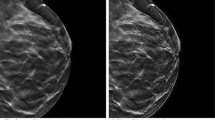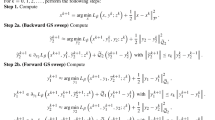Abstract
Spider monkey optimization (SMO) algorithm is a newly introduced nature inspired algorithm (NIA) for solving complex optimization problems based on fission and fusion social structure (FFSS). In this work, two channel linear phase quadrature mirror filter (QMF) bank has been designed using SMO algorithm and a nearly ideal system response is achieved by optimizing the filter tap weights of prototype filter. The overall objective function of the two channel QMF bank which is to be minimized is a linear combination of three main parameters: pass-band error, stop-band residual energy of the prototype filter and square error of the transfer function at quadrature frequency. Simulations have been performed for low and high order QMF banks and the obtained results show that the performance of the suggested novel approach is superior than already existing nature inspired and gradient based algorithms.







Similar content being viewed by others
References
Croisier DE and Galand C (1976) Perfect channel splitting by use of interpolation/decimation/tree decomposition techniques. In: Proceedings of the International Symposium on Information Circuits and Systems, Patras, Greece
Wang H et al (2020) Iterative technique for optimizing two-channel Quadrature mirror, bi-orthogonal and graph filter bank. Signal Process 169:107405. https://doi.org/10.1016/j.sigpro.2019.107405
Vetterli M (1984) Multi-dimensional sub-band coding: some theory and algorithms. Signal Process 6(2):97–112
Sablatash M (2008) Designs and architectures of filter bank trees for spectrally efficient multi-user communications: review, modifications and extensions of wavelet packet filter bank trees. Signal Image Video Process 5(1):09–37
Agrawal SK, Sahu OP (2013) Two-channel quadrature mirror filter bank: an overview. ISRN Signal Process Hindawi. https://doi.org/10.1155/2013/815619 (Article ID 815619)
Kim YG et al (2022) An Efficient Compression Method of Underwater Acoustic Sensor Signals for Underwater Surveillance. Sensors 22(9):3415. https://doi.org/10.3390/s22093415
Jou Y-D, Lin Z-P, Chen F-K (2018) Neural network based design of 2-channel quadrature mirror filter banks. Int J Circ Theory Appl 46(12):2349–2363
Upendar J, Gupta CP, Singh GK (2010) Designing of two channel quadrature mirror filter bank using particle swarm optimization. Digit Signal Process 20(10):304–313
Rafi SM, Kumar A, Singh GK (2013) An improved particle swarm optimization method for multi-rate filter bank design. J Frankl Inst 350(4):757–769
Agrawal SK, Sahu OP (2014) Artificial bee colony algorithm to design two-channel quadrature mirror filter banks. Swarm Evolut Comput. https://doi.org/10.1016/j.swevo.2014.12.001
Ghosh P, Das S, Zafar H (2012) Adaptive-differential-evolution-based design of two-channel quadrature mirror filter banks for sub-band coding and data transmission. IEEE Trans Syst Man Cybern Part C 42(6):1613–1623
Dhabal S, Venkateswaran P (2017) An efficient gbest-guided Cuckoo Search algorithm for higher order two channel filter bank design. Swarm Evolut Comput 33:68–84
Kuldeep B, Singh VK, Kumar A, Singh GK (2015) Design of two-channel filter bank using nature inspired optimization based fractional derivative constraints. ISA Transect 54(1):101–116
Sahu OP, Soni MK, Talwar IM (2006) Marquardt optimization method to design two channel quadrature mirror filter banks. Digit Signal Process 16(6):870–879
Kuldeep B, Kumar A, Singh GK (2015) Design of Quadrature mirror filter bank using Lagrange multiplier method based on fractional derivative constraints. Eng Sci Technol Int J 18:235–243
Ho CYK et al (2010) Two-channel linear phase FIR QMF bank minimax design via global nonconvex optimization programming. IEEE Trans Signal Process 58(8):4436–4441
Kumar A, Singh GK, Anand RS (2011) An improved method for the design of Quadrature mirror filter banks using the Levenberg-Marquardt optimization. Signal image Video Process 7(2):209–220
Zhao R, Lai X and Lin Z (2018) An iterative reweighted minimax algorithm for the design of FRM-based two-channel QMF Banks. IEEE International Symposium on Circuits and Systems (ISCAS), Florence, pp 1–5
Jou Y-D, Lin Z-P, Chen F-K (2018) Improved design of two-channel quadrature mirror filter using explicit toeplitz expressions. In: IEEE 7th Global Conference On Consumer Electronics (GCCE), pp 369–370
Jou Y-D, Lin Z-P, Chen F-K (2017) Design of all-pass-based quadrature mirror filter banks using a lyapunov error criterion, signal processing, computer networks and telecommunication, Okinawa, Japan, ICIIBMS (IEEE), pp 39–42
Singh H, Dwivedi AK, Nagaria D (2021) Quadrature mirror filter bank design based on hybrid bee colony technique. Automatika 62(2):264–274. https://doi.org/10.1080/00051144.2021.1933362
Andrew L, Franques V, Jain V (1997) Eigen design of quadrature mirror filters. IEEE Trans Circ Syst II Analog Digital Signal Process 44(9):754–757
Lu WS, Xu H, Antoniou A (1998) A new method for the design of FIR quadrature mirror-image filter banks. IEEE Trans Circ Syst II Analog Digital Signal Process 45(7):922–926
Engelbrecht AP (2006) Fundamentals of computational swarm intelligence. Wiley, New York
Bonabeau E, Dorigo M, Theraulaz G (1999) Swarm intelligence: from natural to artificial systems (no. 1). Oxford University Press, Berlin
Bansal JC, Sharma H, Jadon SS, Clerc M (2014) Spider monkey optimization algorithm for numerical optimization. Memet Comput 6(1):31–47
Vasundhara Devi R, Siva Sathya S (2017) Monkey behavior based algorithms—a survey. IJ Intell Syst Appl 12:67–86
Swami V, Kumar S, Jain S, Algorithm AISMO, Computing S (2017) Theories and applications. Adv Intell Syst Comput 583:73–81
Kaur A, Sharma H and Sharma N (2017) Disruption Operator-Based spider monkey optimization algorithm, International Conference on Computing, Communication and Automation (ICCCA), pp 216–221
Kumar A, Singh GK, Anand RS (2010) An improved method for the designing quadrature mirror filter banks via unconstrained optimization. J Math Model Algorithm 9(1):99–111
Kumar A, Rafi SM, Singh GK (2012) A hybrid method for designing linear-phase quadrature mirror filter bank. Digital Signal Process 22(3):453–462
Himani, Agrawal SK (2020) Modified Gbest-Guided ABC algorithm approach applied to various nonlinear problems, optical and wireless technologies. Lecture notes in electrical engineering, vol 648. Springer, Singapore. https://doi.org/10.1007/978-981-15-2926-9_67
Baderia K, Kumar A, Singh GK (2015) Design of quadrature mirror filter bank using polyphase components based on optimal fractional derivative constraints. Int J Electron Commun (AEÜ) 69(9):1254–1264
Bansal S, Rattan M (2022) Design of cognitive radio system and comparison of modified whale optimization algorithm with whale optimization algorithm. Int J Inf Technol 14:999–1010. https://doi.org/10.1007/s41870-019-00346-2
Usha-Kirana SP, D’Mello DA (2021) Energy-efficient enhanced Particle Swarm Optimization for virtual machine consolidation in cloud environment. Int J Inf Technol 13:2153–2161. https://doi.org/10.1007/s41870-021-00745-4
Kaviarasan R, Arulmurgan A (2021) Salp swarm bio inspired algorithm for detecting non line of sight vehicles in VANETs. Int J Inf Technol 13:1601–1613. https://doi.org/10.1007/s41870-021-00697-9
Nagpal R, Singh P, Garg BP (2019) Concurrent bacterial foraging with emotional intelligence for global optimization. Int J Inf Technol 11:313–320. https://doi.org/10.1007/s41870-018-0215-z
Preeti DK (2017) Feature selection for face recognition using DCT-PCA and Bat algorithm. Int J Inf Technol 9:411–423. https://doi.org/10.1007/s41870-017-0051-6
Author information
Authors and Affiliations
Corresponding author
Rights and permissions
Springer Nature or its licensor (e.g. a society or other partner) holds exclusive rights to this article under a publishing agreement with the author(s) or other rightsholder(s); author self-archiving of the accepted manuscript version of this article is solely governed by the terms of such publishing agreement and applicable law.
About this article
Cite this article
Agrawal, S.K., Himani Spider monkey optimization method to design two channel quadrature mirror filter bank with linear phase. Int. j. inf. tecnol. 15, 499–510 (2023). https://doi.org/10.1007/s41870-022-01132-3
Received:
Accepted:
Published:
Issue Date:
DOI: https://doi.org/10.1007/s41870-022-01132-3




